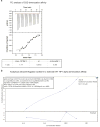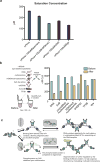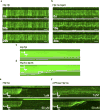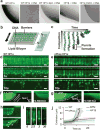Liquid droplet formation by HP1α suggests a role for phase separation in heterochromatin
- PMID: 28636604
- PMCID: PMC5606208
- DOI: 10.1038/nature22822
Liquid droplet formation by HP1α suggests a role for phase separation in heterochromatin
Abstract
Gene silencing by heterochromatin is proposed to occur in part as a result of the ability of heterochromatin protein 1 (HP1) proteins to spread across large regions of the genome, compact the underlying chromatin and recruit diverse ligands. Here we identify a new property of the human HP1α protein: the ability to form phase-separated droplets. While unmodified HP1α is soluble, either phosphorylation of its N-terminal extension or DNA binding promotes the formation of phase-separated droplets. Phosphorylation-driven phase separation can be promoted or reversed by specific HP1α ligands. Known components of heterochromatin such as nucleosomes and DNA preferentially partition into the HP1α droplets, but molecules such as the transcription factor TFIIB show no preference. Using a single-molecule DNA curtain assay, we find that both unmodified and phosphorylated HP1α induce rapid compaction of DNA strands into puncta, although with different characteristics. We show by direct protein delivery into mammalian cells that an HP1α mutant incapable of phase separation in vitro forms smaller and fewer nuclear puncta than phosphorylated HP1α. These findings suggest that heterochromatin-mediated gene silencing may occur in part through sequestration of compacted chromatin in phase-separated HP1 droplets, which are dissolved or formed by specific ligands on the basis of nuclear context.
Conflict of interest statement
The authors declare no competing financial interests.
Figures














Comment in
-
Molecular biology: A liquid reservoir for silent chromatin.Nature. 2017 Jul 13;547(7662):168-170. doi: 10.1038/nature23089. Epub 2017 Jun 21. Nature. 2017. PMID: 28636606 No abstract available.
References
-
- Yamagishi Y, Sakuno T, Shimura M, Watanabe Y. Heterochromatin links to centromeric protection by recruiting shugoshin. Nature. 2008;455:251–255. - PubMed
-
- Eissenberg JC, Elgin SC. The HP1 protein family: getting a grip on chromatin. Current Opinion in Genetics & Development. 10:204–210. - PubMed
-
- Domain-specific Interactions of Human HP1-type Chromodomain Proteins and Inner Nuclear Membrane Protein LBR*. 1997:1–8. - PubMed
-
- Greene EC, Wind S, Fazio T, Gorman J, Visnapuu M-L. In: Single Molecule Tools: Fluorescence Based Approaches, Part A. Walter NG, editor. Vol. 472. Academic Press; 2010. pp. 293–315.
Publication types
MeSH terms
Substances
Grants and funding
LinkOut - more resources
Full Text Sources
Other Literature Sources
Research Materials

